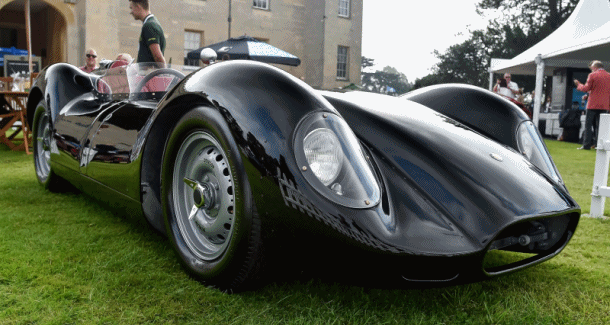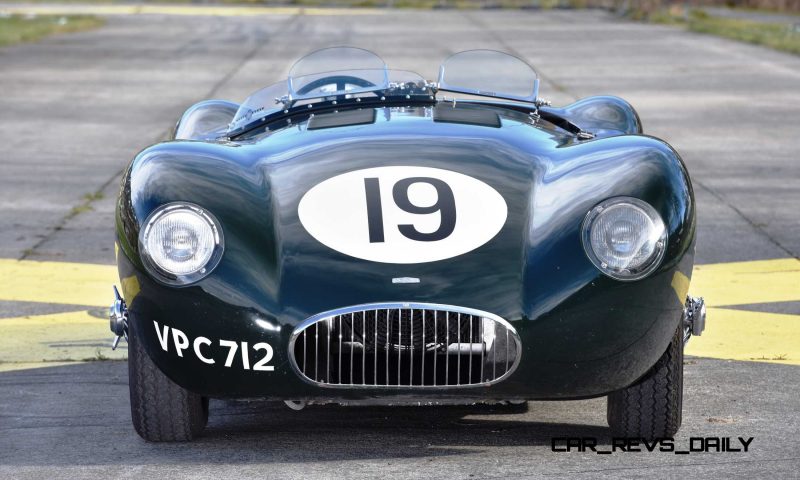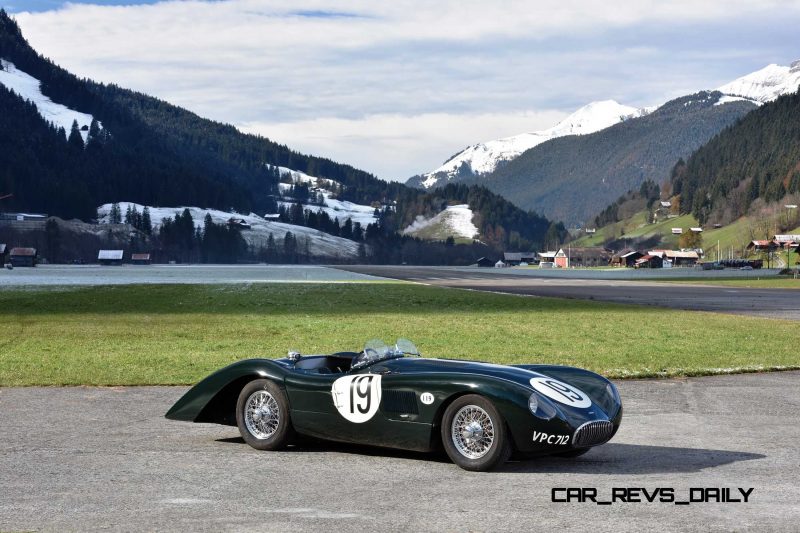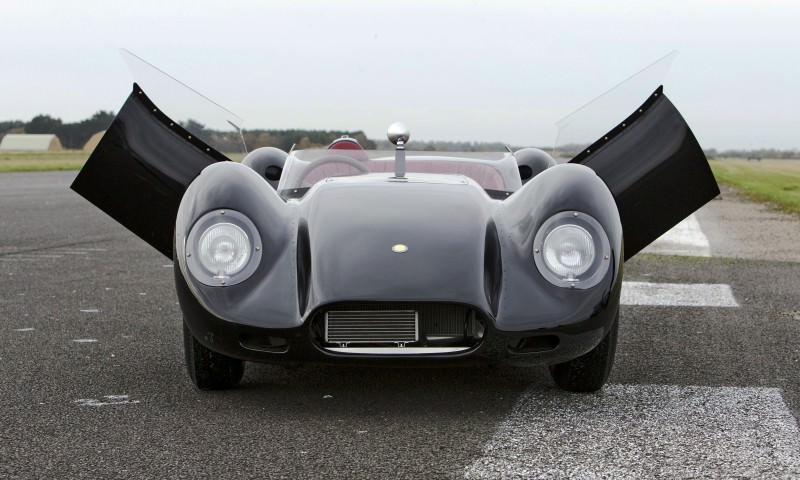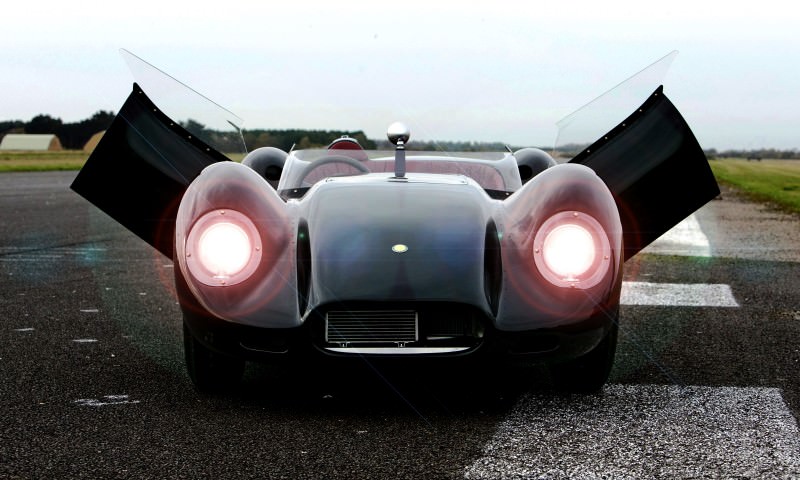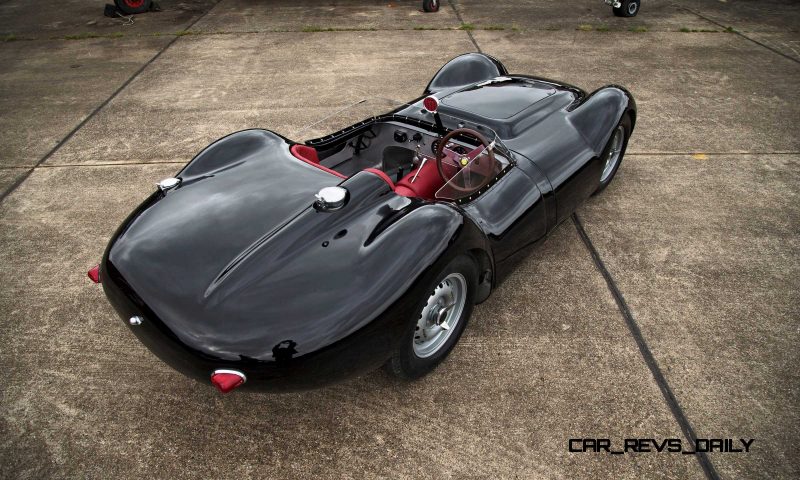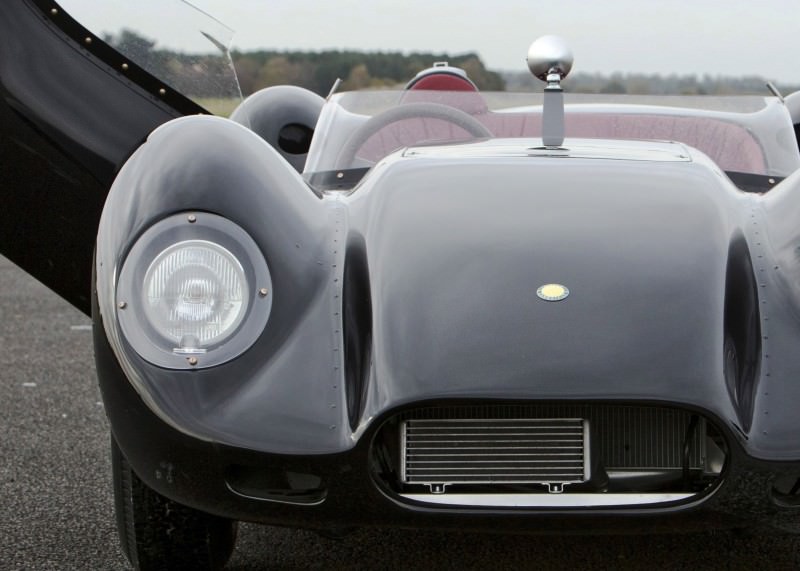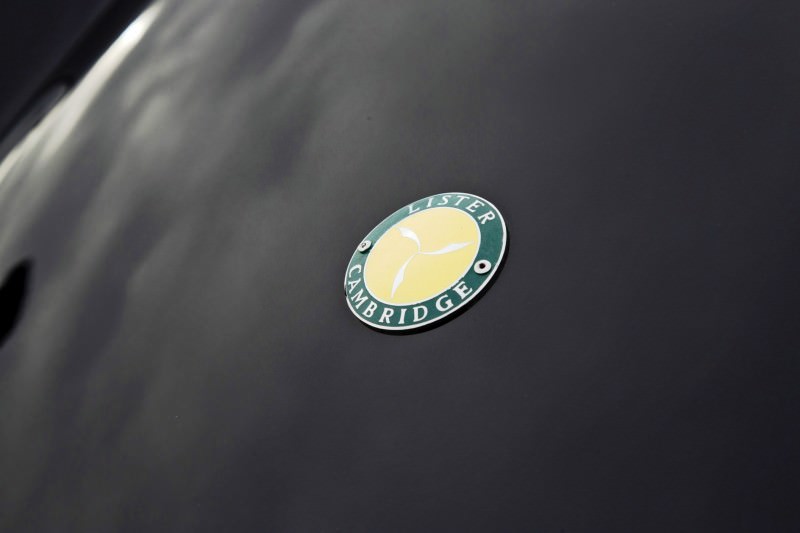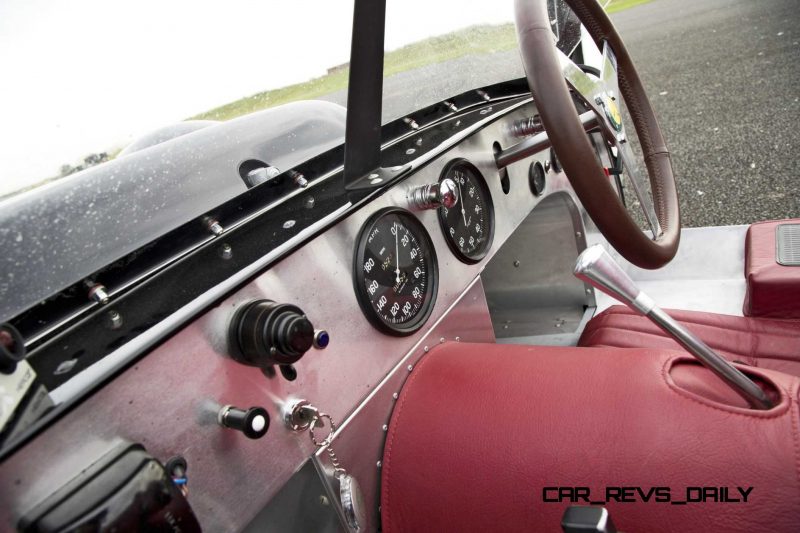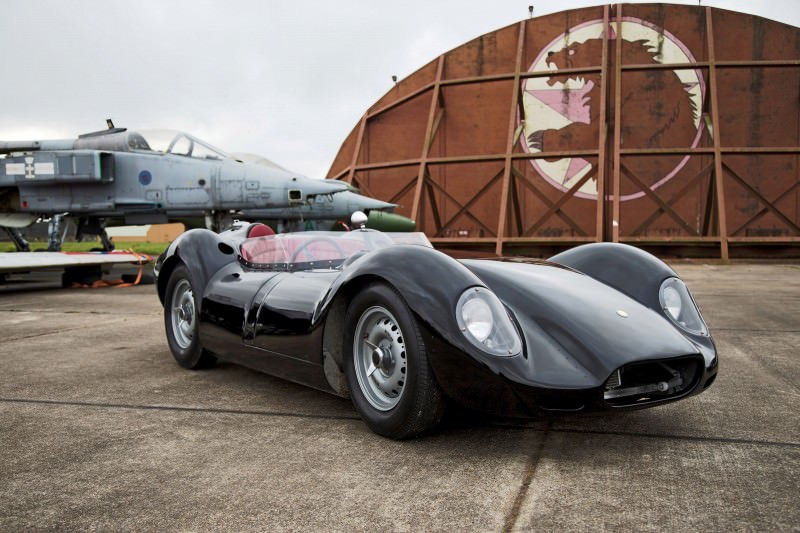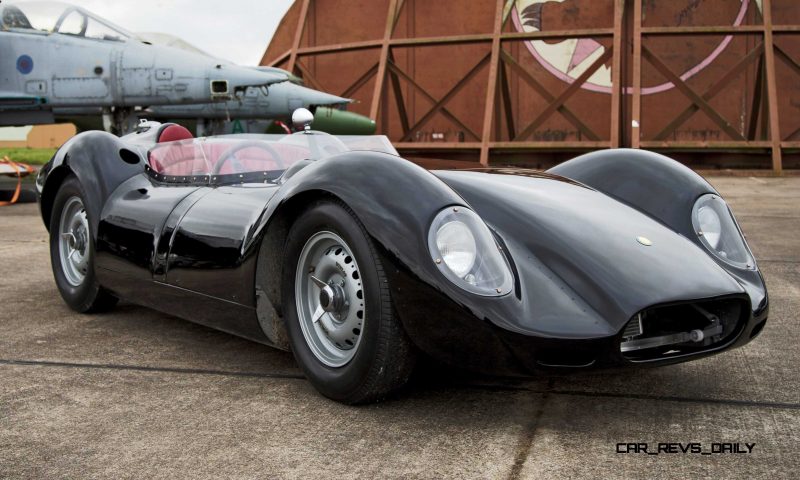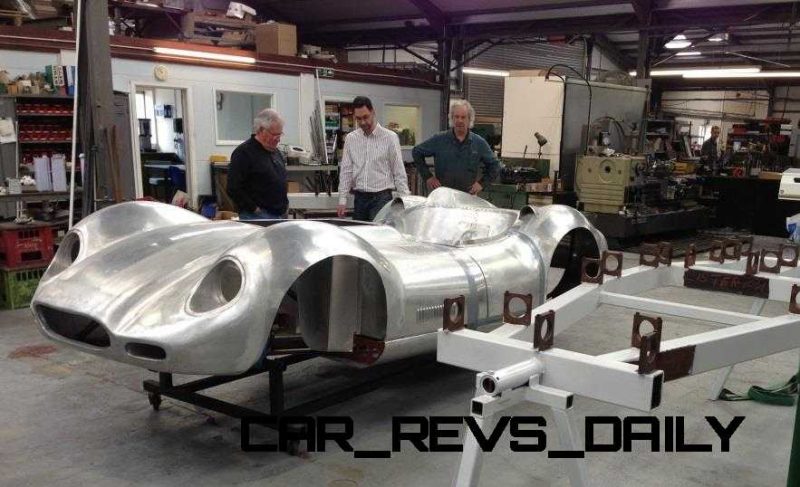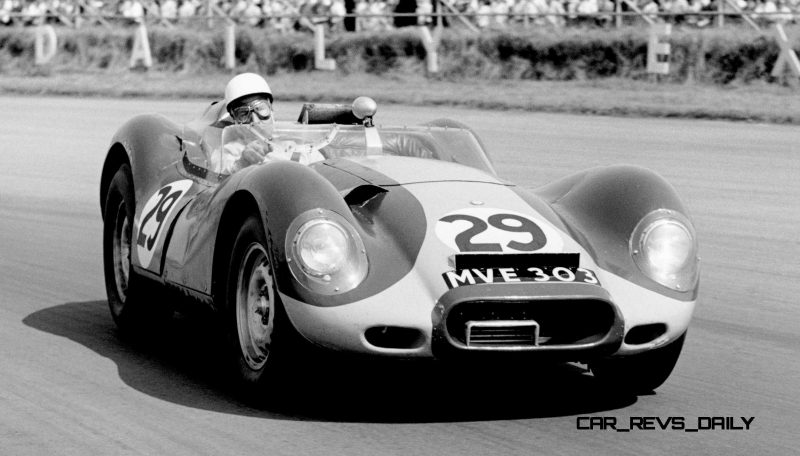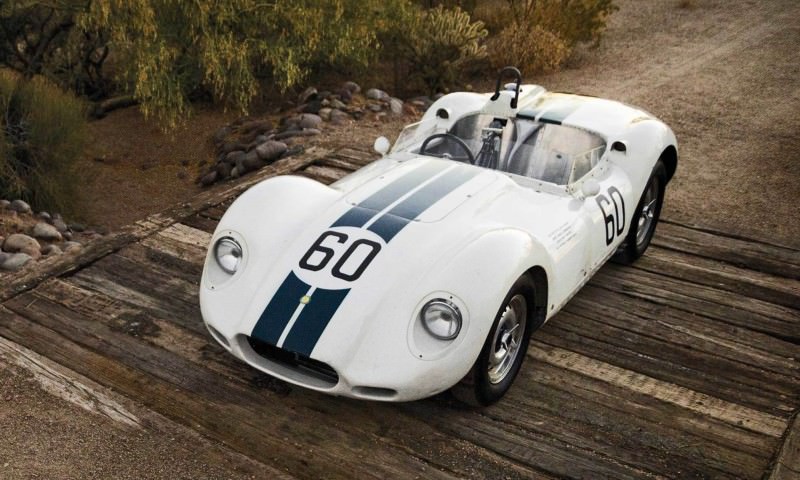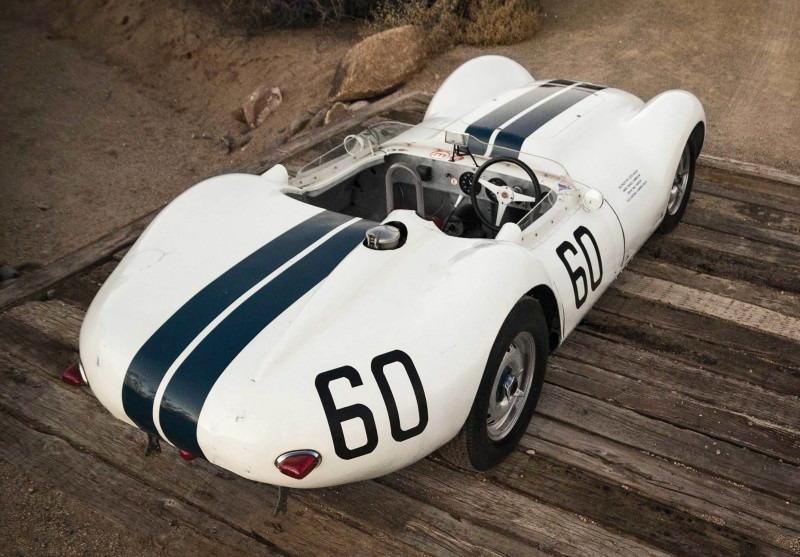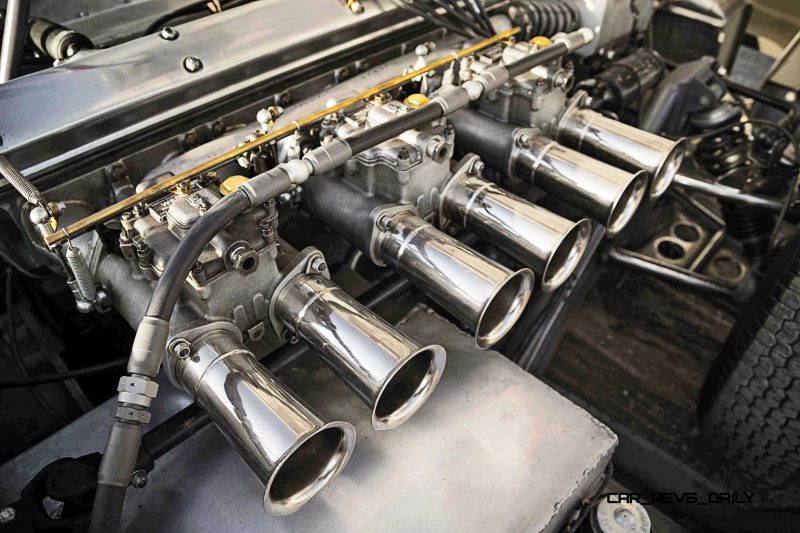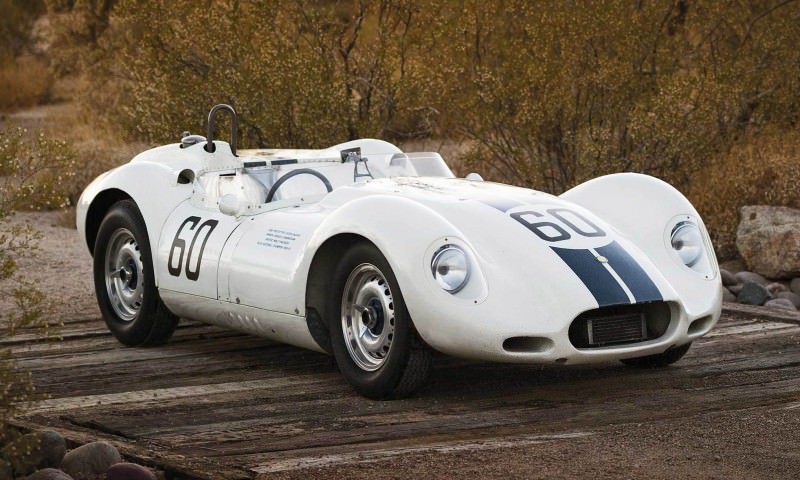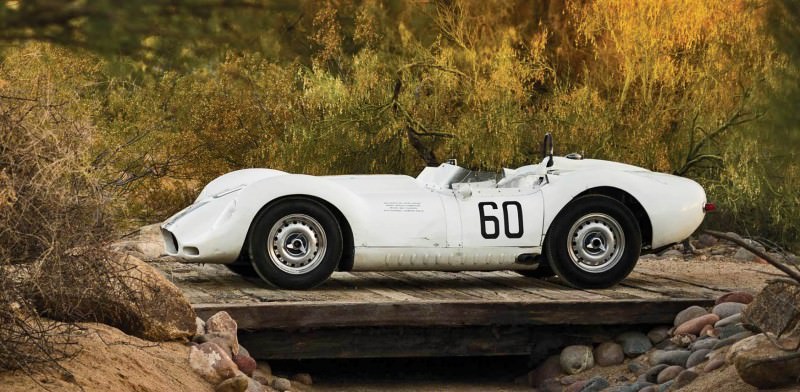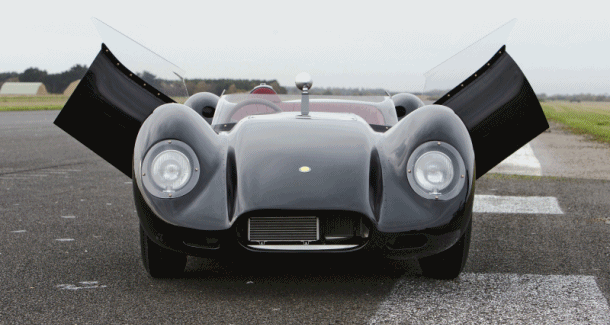 Recreations and replicas of classic racing Jaguars the are all the rage lately, with the Eagle Low Drag GT fetching $700,000 a pop and even Jaguar Special Operations releasing a limited run of racing E-Type coupes.
Recreations and replicas of classic racing Jaguars the are all the rage lately, with the Eagle Low Drag GT fetching $700,000 a pop and even Jaguar Special Operations releasing a limited run of racing E-Type coupes.
These custom-made vehicles are usually the only option to own one at all. Very few racing prototype Jaguars were ever made in the 1950s and 1960s, and most were ultimately ‘raced to death.’ Pushed to the max, these cars often came back from race weekends with crumpled bodywork, torn mechanicals and need of major TLC. Most were parted-out and the shells retired to the smelter.
But before the E-Type was racing to future glory in the 1960s, however, and many cars like the steamliner C-type replica (in green) succumbed to history, there was one true star in the catalog that not only won races: but survived intact and lived to tell the tale.


That star car was the 1958 Lister Knobbly.
Lister Cars is reborn this year and producing a limited number of resto-modded homage examples. Using the original plans and car for exact inspiration, the 2015 model offers a choice of Jaguar 3.8-liter straight-six or a trusty small-block V8 from Chevrolet.
The stunning and seductive Knobbly Lister makes its public debut this week at the Autosport International car show — with orders taken from interested parties starting today!
2015 LISTER Jaguar Knobbly 60th Anniversary Edition
LISTER JAGUAR ‘KNOBBLY’ 60th Anniversary Edition
To celebrate our 60th anniversary you can now order a brand new original specification 1958 Works Lister Jaguar ‘Knobbly’, built to meet current FIA Appendix K race regulations, direct from the Lister Factory in Cambridge for road or race use.
Now, with state of the art facilities which include CNC machining and CAD design, George Lister Engineering are even better placed to deliver a historic race winning car. Brian Lister’s original working drawings and manufacturing jigs have been re-commissioned and some of the old guard have been called up into service, including Martin Murray, Colin ‘Chippy’ Crisp, Graham ‘Curley’ Hutton, Laurence Pearce and even Brian Lister himself. Heading up the manufacturing project is Mark Hallam, Technical Director at George Lister Engineering.
The cars will be built to the specifications as in 1958, out of the box and ready to race with BHL(C) chassis insignia and FIA/HTP accreditation. There are two choices of engine: The race proven, Jaguar D Type 3.8 litre 6 cylinder engine complete with the famous wide-angle cylinder head and dry sump lubrication or the 4,640cc Chevrolet Corvette V8 race specification that was originally built for the US racing market by Costin.
All race preparation and track commissioning will be undertaken by Chris Keith-Lucas of CKL Developments. Last but not least, that fantastic streamlined ‘Knobbly’ body will be re-created using the original jigs.
A series of Lister historic race meetings are planned for 2015, including the Brian Lister Cup that will be run alongside the Stirling Moss Trophy by Motor Racing Legends.

http://listercars.com/
Technical Specification
|
|
|
|
|
Jaguar 3.8 |
|
|
Chevrolet V8 |
|
|
|
|
|
PERFORMANCE (MANUFACTURER’S ESTIMATES) |
|
||||
Acceleration 0-60 mph |
|
|
|
4.3 seconds |
|
|
4.9 seconds |
|
Acceleration 0-100 mph |
|
|
|
10.1 seconds |
|
|
12.1 seconds |
|
Max Speed |
|
|
|
181 mph |
|
|
168 mph |
|
|
|
|
|
ENGINES |
|
||||
Engine Type |
|
|
|
Jaguar D Type, race specification |
|
|
Chevrolet Corvette V8, race specification |
|
Engine Size |
|
|
|
3,781cc, bore and stroke 87mm x 107mm |
|
|
4,640cc (283cu/in), bore and stroke 98mm x 76mm |
|
Cylinders |
|
|
|
6 cylinders in line, cast iron C8610 period block |
|
|
8 cylinders V8, cast iron block |
|
Cylinder Head |
|
|
|
35/40 degree wide angle D Type alloy head |
|
|
OHV twin cast iron heads |
|
Lubrication |
|
|
|
Full flow, twin oil pumps, dry sump system with oil cooler |
|
|
Full flow, single oil pumps, with oil cooler |
|
Compression Ratio |
|
|
|
10:1 |
|
|
9.5:1 |
|
|
|
|
|
FURTHER SPECIFICATION |
|
||||
Camshafts |
|
|
|
Twin OHC, high lift racing 110 degree duration |
|
|
Single camshaft with pushrods |
|
Gearbox |
|
|
|
Jaguar D Type with Plessey Pump (blanked) 4 speed all synchromesh |
|
|
Chevrolet Corvette, 4 speed, all synchromesh |
|
Clutch |
|
|
|
Triple plate |
|
|
Single or twin plate |
|
Axle |
|
|
|
Salisbury limited slip differential, all alloy case, ratio 3.54:1 |
|
|
Salisbury limited slip differential, all alloy case, ratio 3.54:1 |
|
Fuelling |
|
|
|
3x Weber DCO3 sand cast correct period carburettors |
|
|
4x Holley downdraught carburetors or Rochester fuel injection |
|
Chassis |
|
|
|
3 ins x 16g seamless engineering tube |
|
|
3 ins x 14g seamless engineering tube |
|
Steering |
|
|
|
Derrington 15″ wheel with rack and pinion, 2 turns lock to lock |
|
|
Derrington 15″ wheel with rack and pinion, 2 turns lock to lock |
|
Suspension F |
|
|
|
Independent wishbone arms with coil over shocks and anti roll bar |
|
|
Independent wishbone arms with coil over shocks and anti roll bar |
|
Suspension R |
|
|
|
De-Dion with coil over shocks |
|
|
De-Dion with coil over shocks |
|
Brakes |
|
|
|
Girling 12″ discs front and rear with mechanical handbrake |
|
|
Girling 12″ discs front and rear with mechanical handbrake |
|
Wheels |
|
|
|
Dunlop racing peg drive alloys 5″ x 16″ with knock off spinners |
|
|
Dunlop racing alloys 16″ with knock off spinners |
|
Tyres |
|
|
|
Dunlop racing covers, front 600×16, rear 650×16, spare 600×16 |
|
|
Dunlop racing covers, front 600×16, rear 650×16, spare 600×16 |
|
Body |
|
|
|
Hand-formed lightweight aluminium alloy |
|
|
Hand-formed lightweight aluminium alloy |
|
Length |
|
|
|
13 ft 6 ins |
|
|
13 ft 6 ins |
|
Wheelbase |
|
|
|
7 ft 6-3/4 ins |
|
|
7 ft 6-3/4 ins |
|
Track |
|
|
|
Front 4 ft 4 ins, rear 4 ft 5-1/2 ins |
|
|
Front 4 ft 4 ins, rear 4 ft 5-1/2 ins |
|
Height |
|
|
|
2 ft 3 ins at scuttle |
|
|
2 ft 4 ins at scuttle |
|
Weight |
|
|
|
1,736 lbs (dry) |
|
|
1,920 lbs (dry) |
|
Distribution |
|
|
|
Front 48%, rear 52% |
|
|
Front 50%, rear 50% |
|
Fuel Tank Cap |
|
|
|
38/42 imperial gallons |
|
|
38/42 imperial gallons |
|
Engine Oil Cap |
|
|
|
5 imperial gals |
|
|
1.5 imperial gals |
|
Power |
|
|
|
330bhp at 6750 rpm |
|
|
315bhp at 6000 rpm |
|
Torque |
|
|
|
295 lbs ft at 4,250 rpm |
|
|
290 lbs ft at 4,000 rpm |
|
Price |
|
|
|
£POA |
|
|
£POA |
|
Lister Bristol
The Lister-Bristol came into operation in mid-1954 causing something of a sensation when Archie Scott Brown won the 2.0-litere class
The first Lister-Bristol was registered MVE 303, after Brian had visited the Cambridge motor vehicle licensing office once more “to see what they had got,” as he put it. In view of the fame this registration mark has acquired in historic motor racing circles it’s worth digressing into its origins. Dick Barton: “I’ve always said that it was Brian who said to me that when he registered the cars in Cambridge, he chose 303 because of the association with the rifle bullet. But he said the idea was mine, so there’s a bit of confusion there.” Nevertheless, both men agree that likening the speed of the car to a .303 bullet fired from a Lee Enfield service rifle (which both would have encountered during their time in the RAF) was highly appropriate.
Lister Maserati
Brian Lister purchased a Maserati A6GCS engine and transmission from the Italian manufacturer in 1956 in hopes of adding more power to Lister Chassis number BHL1
He believed the increased power would help continue the team’s success in the 2-liter class. This is the only Lister-Maserati constructed and was the factory cars driven by legendary Archie Scott Brown, called the ‘King for the 4-wheel Drift’ by Fangio. The Lister-Maserati raced with varying degrees of success throughout 1956 and 1957, including four first-place finishes and twelve D.N.F.s.
The ‘Archie’ Lister (MVE303)
When one thinks of legendary racing cars of the late 1950s, words like sleek, sexy, and dramatic come to mind. Cambridge manufacturer Brian Lister’s offering was all of the above, but it found its groove in rather unique contours that nonetheless gave it the popular nickname “Knobbly”.
Designed by Brian Lister to meet windshield height regulations set by the FIA, while also minimizing the frontal area of a car powered by a rather large three-liter Jaguar engine, its aluminum body featured a large central bump covering the engine, which fell off in wide grooves on either side and aft, and incredibly curvaceous streamlined fenders and headrest. The result was an athletic-appearing, distinctive racing car that took the sporting world by storm when it made its debut in February 1958 and made famous by Archie Scott Brown
Lister Flat-Iron
The flat-iron Lister-Jaguar – as ‘HCH 736’ became known – is perhaps the most famous of the non-works/non-Cunningham team cars.
As ‘the other Lister-Jaguar’ run concurrently with the works’ famous first prototype that was driven by Archie Scott-Brown through 1958, it was the Dick Walsh-run car which Bruce Halford and Brian Naylor drove at Le Mans, and then in 1959 became the Scottish Border Reivers’ team’s entry most notably for the youthful Jim Clark, and in which the World’s greatest racing driver first developed so much of his supreme skill. Partly because it has been unused for so very many years it has re-emerged as an extremely important, truly historic sports-racing car, and its Clark connection gives it almost iconic status.
Lister Monzanapolis
The Monza Lista was conceived and built in little more than two months, a rush job that was completed in the paddock at the Nürburgring, where Ecurie Ecosse were running three D-types in the 1,000km race.
Autosport 6 June 1958 described the Monza Lister as having quite substantial alterations, such as the 3.8 litre D-type engine being off-set to the nearside, strengthened de Dion tube with a large diameter centre pin to retain the sliding block, stronger front suspension wishbones, and even friction-type dampers to augment the standard telescopic units. Although the single-seater Lister was handsome, it proved slower than Ecurie Ecosse’s two D-types at the Monza ‘Race of Two Worlds’ in 1958 – and even these were nowhere near as competitive against the American Indy cars as they had been in 1957,
Lister Costin
In order that Listers could continue to be competitive in the big-engine classes in the 1959 season, Brian Lister was particularly receptive to the ideas of aerodynamicist Frank Costin, who had already suggested detail modifications to the ‘knobbly’ cars during 1958
Costin persuaded Lister that many benefits could be gained from a multi-tube spaceframe, lighter and more rigid than the trusty twin-tube design which had featured in all Lister sports cars to date – especially if it carried a truly aerodynamic body. Accordingly, in October 1958 he was taken on full-time and given his own office and even an assistant (David Bennoy), with the brief of designing a car with exactly these features. But it soon became apparent that the spaceframe was complex and would take some months to design and develop, so as an interim measure the aerodynamic body intended for it would be produced first and fitted on the existing chassis which is how the ‘Costin’ Lister-Jaguar came about.
Lister Le Mans
The famous Lister Jaguar connection made its commercial reappearance in 1986. Based in Leatherhead, with engineering input by Laurence Pearce, approximately 90 tuned Jaguar Le Mans were produced, the emphasis being very much on super car performance.
For those who felt the standard 5.3 litre V12 Jaguar engine a bit insipid, Lister added a comprehensive tuning package, first of all taking the engine out to 6 litres. The fuel injection was modified with 4 additional injectors and throttle bodies. The engine management system was tweaked, the heads gas flowed with larger valves fitted and to take the power, the crankshaft was nitrided, whilst Cosworth conrods carried special forged pistons increasing the compression ratio to 11.7:1. New bearings and a modified oil system were also deemed necessary in order to reliably deliver the 482bhp that it could now produce. Clearly the suspension and braking were going to need some attention, and this they duly got. The car was made to look the part too with a full body kit, superb leather Lister Recaro interior and some very sexy Lister alloy wheels. From the outset this was not going to be a cheap motor car, and it certainly wasn’t, costing a cool £88,000 in 1988.
Lister Storm
The Lister Storm was a homologated racing car built by Lister Cars in 1993.
The Storm used the largest V12 engine fitted to a production road car since World War II, a 6,996 cc Jaguar unit based on the one used by the Jaguar XJR Sportscars that competed at the 24 Hours of Le Mans. Due to the high price of the vehicle, only four examples were produced before production of the road-going Storm ceased. Only three Storms survive today, although the Lister company continues to maintain racing models.
http://listercars.com/

Tom Burkart is the founder and managing editor of Car-Revs-Daily.com, an innovative and rapidly-expanding automotive news magazine.
He holds a Journalism JBA degree from the University of Wisconsin – Madison. Tom currently resides in Charleston, South Carolina with his two amazing dogs, Drake and Tank.
Mr. Burkart is available for all questions and concerns by email Tom(at)car-revs-daily.com.

